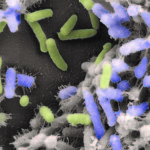Link to Pubmed [PMID] – 36861972
Link to DOI – 10.1128/mbio.03432-22
mBio 2023 Apr; 14(2): e0343222
It is unclear how gene order within the chromosome influences genome evolution. Bacteria cluster transcription and translation genes close to the replication origin (oriC). In Vibrio cholerae, relocation of s10-spc-α locus (S10), the major locus of ribosomal protein genes, to ectopic genomic positions shows that its relative distance to the oriC correlates to a reduction in growth rate, fitness, and infectivity. To test the long-term impact of this trait, we evolved 12 populations of V. cholerae strains bearing S10 at an oriC-proximal or an oriC-distal location for 1,000 generations. During the first 250 generations, positive selection was the main force driving mutation. After 1,000 generations, we observed more nonadaptative mutations and hypermutator genotypes. Populations fixed inactivating mutations at many genes linked to virulence: flagellum, chemotaxis, biofilm, and quorum sensing. Throughout the experiment, all populations increased their growth rates. However, those bearing S10 close to oriC remained the fittest, indicating that suppressor mutations cannot compensate for the genomic position of the main ribosomal protein locus. Selection and sequencing of the fastest-growing clones allowed us to characterize mutations inactivating, among other sites, flagellum master regulators. Reintroduction of these mutations into the wild-type context led to a ≈10% growth improvement. In conclusion, the genomic location of ribosomal protein genes conditions the evolutionary trajectory of V. cholerae. While genomic content is highly plastic in prokaryotes, gene order is an underestimated factor that conditions cellular physiology and evolution. A lack of suppression enables artificial gene relocation as a tool for genetic circuit reprogramming. IMPORTANCE The bacterial chromosome harbors several entangled processes such as replication, transcription, DNA repair, and segregation. Replication begins bidirectionally at the replication origin (oriC) until the terminal region (ter) organizing the genome along the ori-ter axis gene order along this axis could link genome structure to cell physiology. Fast-growing bacteria cluster translation genes near oriC. In Vibrio cholerae, moving them away was feasible but at the cost of losing fitness and infectivity. Here, we evolved strains harboring ribosomal genes close or far from oriC. Growth rate differences persisted after 1,000 generations. No mutation was able to compensate for the growth defect, showing that ribosomal gene location conditions their evolutionary trajectory. Despite the high plasticity of bacterial genomes, evolution has sculpted gene order to optimize the ecological strategy of the microorganism. We observed growth rate improvement throughout the evolution experiment that occurred at expense of energetically costly processes such the flagellum biosynthesis and virulence-related functions. From the biotechnological point of view, manipulation of gene order enables altering bacterial growth with no escape events.








